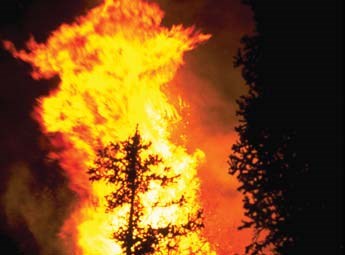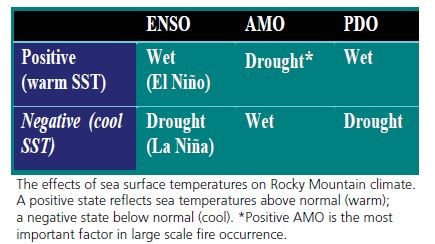Last updated: November 8, 2022
Article
Subalpine Forest Fires and Climatic Variation

The Question: How does fire occurrence relate to climate variability?
Climate can affect fires by creating fire prone conditions like drought. Understanding the relationship between fire occurrence and climate variability can help predict how future climate change scenarios may impact wildfire patterns. The goal was to ascertain the relationships between wildfire occurrences in subalpine forests with (1) climate variability (specifi cally drought); (2) broad scale climate patterns caused by sea surface temperatures (SST) in the tropical Pacific (El Niño Southern Oscillation or ENSO), north Pacific (Pacific Decadal Oscillation or PDO), and northern Atlantic oceans (Atlantic Multidecadal Oscillation or AMO), which oscillate between relatively warm and cool phases; and (3) temporal variation of sea surface temperatures in the Pacific and Atlantic at short (one to two year) and long (100+ years) time-scales.

The Project: Compare fire history to climate records.
Using dendroecology analyses (tree-cores and fire scar cross sections) and vegetation mapping, Jason Sibold and Thomas Veblen of University of Colorado at Boulder reconstructed the fire re history (the year and size of past fires) from 1650 to present for 74,000 acres of subalpine forest in the southern part of the park. They compared the fire history of the park with known tree-ring width data. These tree-ring indices correlate strongly with rainfall and temperature in the region; therefore, tree rings are a good indicator of drought and can be used as a proxy record of climate conditions. Researchers tested for relationships between years in which large fires occurred and (1) drought; (2) broad scale climate patterns, including SSTs; and (3) diff different combinations of SSTs in the three ocean regions (eight combinations between the three oscillation patterns).
The Results: Large fire events are associated with extreme drought conditions, especially those caused by broad scale climate patterns.
This study suggests that regional changes in precipitation play a major role in large-scale fires in subalpine forests, which take place during extreme regional drought conditions. Large fires in the subalpine are not necessarily related to above average moisture conditions preceding fires, which increase fine fuels like grasses and are essential for fire occurrence in some lower-elevation forest types. These results indicate that large fires in the park depend only on severe drought within the fire year. This is in sharp contrast to the lower-elevation ponderosa pine forests, which typically have fires that follow fuel-enhancing wet periods.
